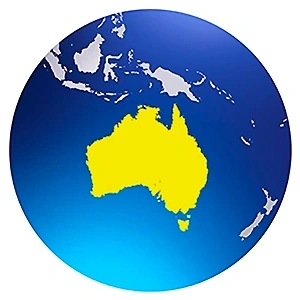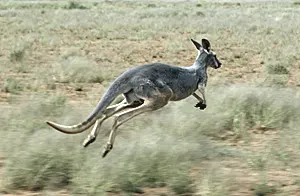Australia - Its People, Animals and Places

Photo: Location of Australia on the globe
Australia is the sixth-largest country with the 13th-largest economy in the world. It is a culturally diverse democracy with approximately 26 million people. Located in the southern hemisphere close to Asia, Australia has a fascinating history, people, and diverse wildlife. A summary is provided on this page. For more detailed explanations, please click on an image above or select a topic from the table of contents and begin exploring!
The Land Called Australia The Great Southern Continent
Australia is located in the Southern Hemisphere in southeast Asia. It is the world’s smallest continent and its biggest island. It is bounded by the Indian Ocean on the west, the Timor, Arafura, and Coral Seas to the north, the Pacific Ocean to the east, and the Southern Ocean and Tasman Sea to the southeast. Australia is the 6th largest country and the 13th largest economy globally. Australia is a stable, culturally diverse Western democracy with a multicultural English-speaking population of approximately 26 million people.
The official name of the country is the Commonwealth of Australia. The six states are: Queensland, New South Wales, South Australia, Tasmania, Victoria and Western Australia. The two Territories are: Australian Capital Territory and the Northern Territory. Canberra is the capital of Australia.
The People of Australia Come from Around the World
Photo: Australian multi-cultural society
The people of Australia are called Australians. Australia has a multicultural population of 26 million people. Over 90% of the population is made up of immigrants or the children of immigrants who arrived here during the last two centuries. Almost one in four Australians alive today was born overseas. Australians speak English. But we have our own special words and phrases referred to as Strine.
The Aborigines were the first humans to arrive in Australia about 50,000 years ago. Europeans arrived only in 1776. Since then, migrates from over 200 countries have come and settled here.
The Animals and Plants of Australia Australia has 10 per cent of the world's biodiversity

Photo: Kangaroo hopping
Australia has many unusual plants and animals. More than 80% of its mammals, reptiles, frogs, and flowering plants are unique to Australia. More than 140 species of marsupials, such as the Kangaroo, Koala and Wombat , live in Australia. Egg-laying mammals called monotremes, called monotremes such as the Platypus and Echidna, are unique to Australia. Nearly 50% of its birds and almost all of its freshwater fish are found nowhere else in the world.
The Great Barrier Reef The Largest Coral Reef in the World
Photo: Clown fish in the Great Barrier Reef
Australia’s marine environment is home to 4000 species of fish, 1700 species of coral , 50 types of marine mammals and a wide range of sea-birds. About 80 per cent of marine species found in southern Australian waters occur nowhere else in the world. The Great Barrier Reef is the largest coral reef in the world. It's stunning.
A Note About This Web Site
This website was originally written in 1997 by Trishan, an eleven year old Australian kid and his dad. Back then, the internet was in its infancy, and we were one of the first websites about Australia. We won countless awards, including the "Internet Site of the Year" award for being one of the best websites in Australia. Over the years, this site has been highly rated in Google searches. We have had more than 30.3 million visitors. Over the years we have updated the site with lots of additional content, new video clips (which didn't exist when the page was initially written) and lots more. We have, however, maintained some of the "look and feel" of the original website. For example, the large Imap image on the top of this page has been with us since the beginning. It appeared on the original website, and we have retained it. We hope you find our site fun and informative.